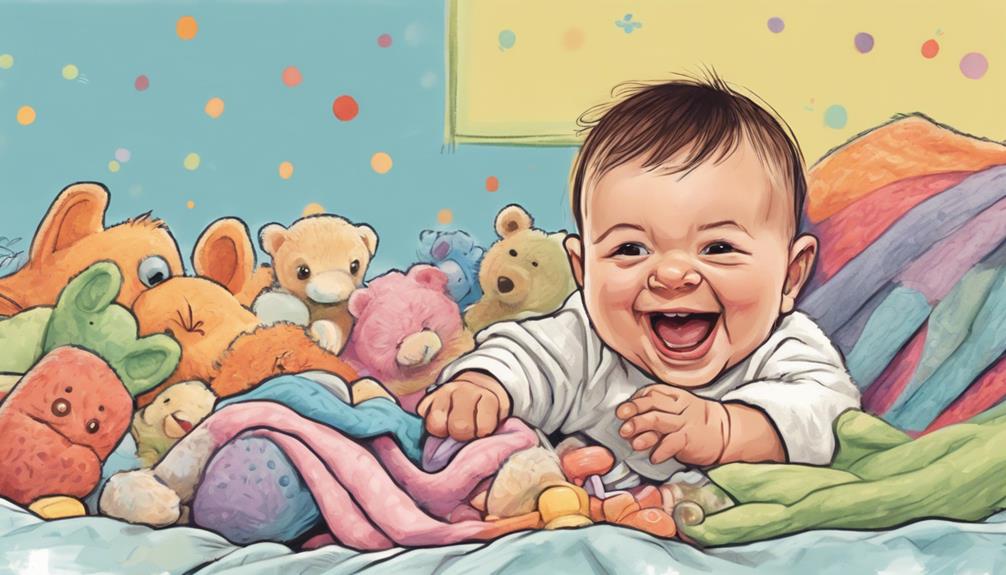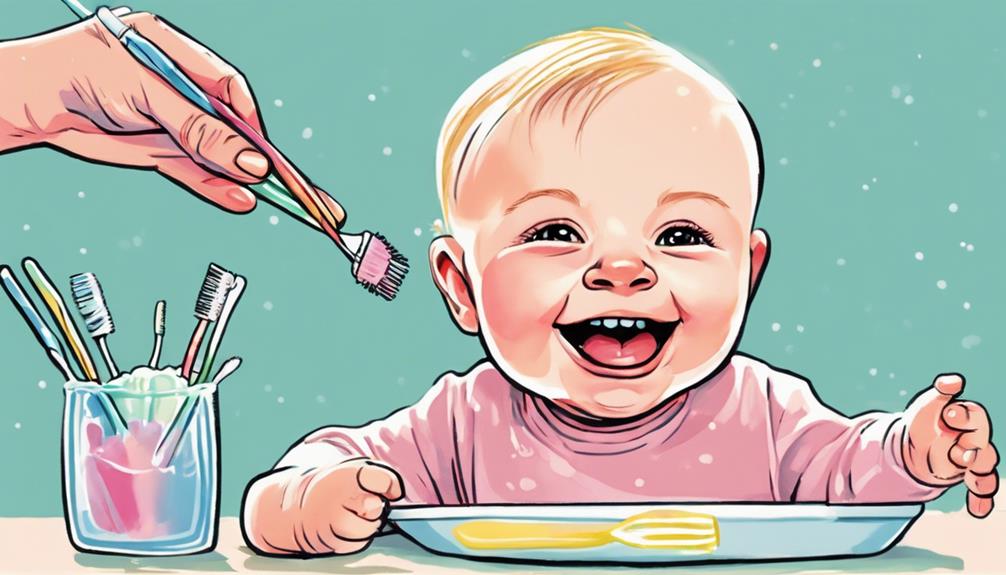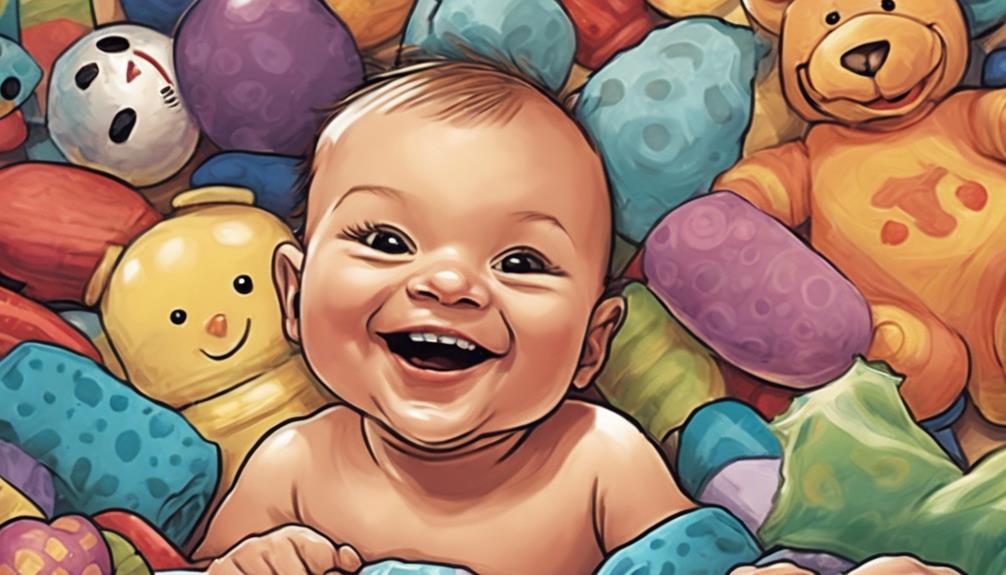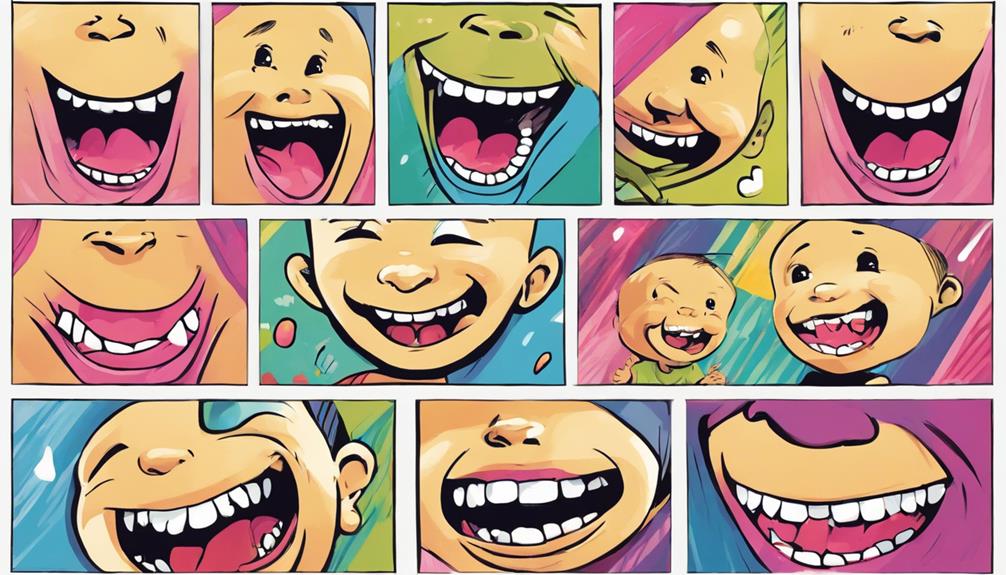Babies can start teething as early as 3 months old, but most will see their first teeth emerge between 4 to 7 months. The first teeth you might notice are usually the lower central incisors, which typically appear around 6 months. However, some babies may not start teething until they're closer to 12 months. Keep in mind that each child is unique, and their teething timeline can vary. If you want to know more about signs of teething and how to soothe your baby's discomfort, you'll find plenty of helpful tips ahead.
Key Takeaways
- Teething usually begins between 4 to 7 months, but some infants may start as early as 3 months or as late as 12 months.
- The first teeth to emerge are typically lower central incisors, appearing around 6 months.
- Some infants are born with natal teeth, although this is rare.
- Most children have a complete set of 20 primary teeth by age 3, but timelines can vary significantly.
Understanding Teething
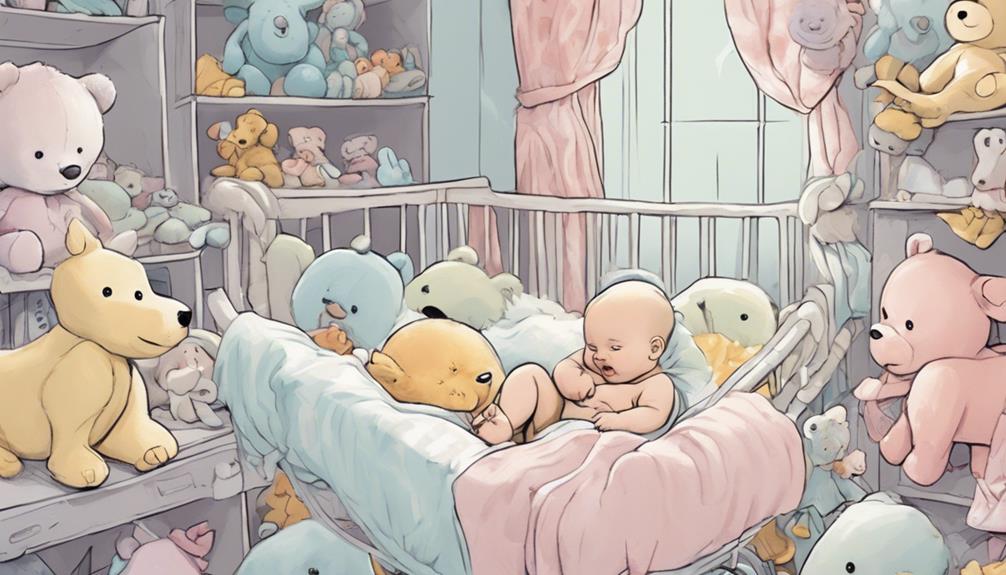
Teething is a natural process that usually starts between 4 to 7 months, but some babies might surprise you by starting as early as 3 months. The arrival of the first tooth can be an exciting milestone, but it also brings discomfort for your little one.
As a parent, it's important to recognize the signs of teething, which can include increased drooling, irritability, and a strong desire to chew on objects. You might notice your baby's symptoms intensifying as their primary teeth push through the gums.
Typically, the lower central incisors are the first to emerge, followed by the upper front teeth about 4 to 8 weeks later. While most children will have a complete set of 20 primary teeth by age 3, individual timelines can vary considerably.
It's vital to monitor your baby's discomfort and understand that mild temperature elevations can occur, but high fever typically isn't associated with teething. By grasping the teething timeline and its symptoms, you'll be better equipped to support your baby during this challenging phase and distinguish between normal teething discomfort and potential health issues.
Teething Start Age
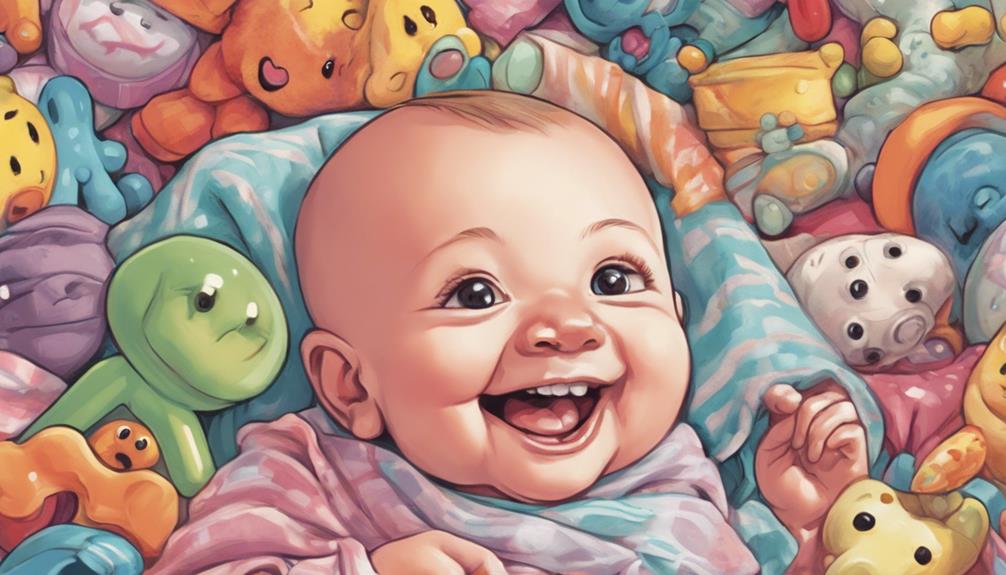
When it comes to teething, you might be surprised to learn that some babies start as early as 3 months, while most usually begin around 6 months.
Typically, the first teeth to show up are the lower central incisors, followed by the upper ones a few weeks later.
Understanding this timeline can help you better prepare for your little one's teething journey.
Typical Teething Age Range
Most babies start to cut their first teeth between 4 and 7 months, although some might surprise you by starting as early as 3 months or as late as 12 months.
Generally, the first teeth to emerge are the lower central incisors, which typically appear around 6 months. You'll likely notice teething symptoms such as drooling, irritability, or a desire to chew on objects during this time.
As your baby progresses, the upper central incisors usually erupt about 4 to 8 weeks after the lower ones. By age 1, many infants will have at least a few teeth, but it's important to remember that some mightn't have any yet. This variation is completely normal, and every child develops at their own pace.
Most children will have a full set of 20 primary teeth by the age of 3. As your baby starts teething, keep an eye on their progress and be mindful of their comfort.
Understanding the typical teething age range can help you support your little one during this significant developmental milestone.
Early Teething Cases
Some babies surprise their parents by cutting their first teeth as early as 3 months, defying the typical timeline. While most infants typically start teething around 6 months, early teething cases can lead to a variety of experiences.
Here are three significant points to take into account:
- First Tooth Timing: The first tooth usually to appear are the lower central incisors, which often emerge between 5 to 7 months.
- Born with Teeth: In rare instances, some infants are born with teeth, referred to as natal teeth, which can be a shock for new parents.
- Delays in Teething: It's essential to watch for signs of teething, as some babies may not have any teeth by their first birthday. This delay could indicate potential dental issues.
If you notice your baby showing signs of teething at just a few months old, keep an eye on their progress.
Remember, each child is unique, and while early teething cases are less common, they do happen.
Trust your instincts and consult your pediatrician if you have any concerns about your baby's teething journey.
Common Teething Symptoms
Teething often brings a mix of symptoms that can leave your little one feeling irritable and uncomfortable. As a parent, you might notice several common teething symptoms starting at around 3 months. These can include swollen gums, excessive drooling, and a strong desire for your baby to chew on objects.
| Teething Symptoms | Description |
|---|---|
| Swollen Gums | Gums may appear red and puffy. |
| Irritability | Your baby might be cranky and hard to soothe. |
| Temperature Elevation | A slight rise in temperature, but not over 100.4°F. |
| Chewing Objects | Your baby may chew on toys, fingers, or other items. |
While discomfort and disrupted sleep patterns are common, not every baby experiences pain during teething. It's crucial to keep an eye on the symptoms. If you notice signs like high fever or diarrhea, remember these aren't linked to teething. In such cases, it's best to consult your pediatrician for guidance. Understanding these teething symptoms can help you provide comfort to your little one during this challenging time.
Soothing Teething Discomfort

When your baby starts teething, you can help ease their discomfort with a few simple methods.
Gently massaging their gums, using chilled teething items, and providing safe chewable options can make a significant difference.
Let's explore these techniques to keep your little one comfortable during this challenging time.
Gentle Gum Massage
Gently massaging your baby's gums with a clean finger can provide immediate relief from discomfort by applying soothing counterpressure to sore spots. This gentle gum massage is a safe and effective teething method to soothe teething pain, especially when you notice signs of discomfort like irritability or excessive drooling.
Here are three reasons why you should consider this technique:
- Promotes Oral Health: Regular gums massage can stimulate blood flow, easing inflammation and making the eruption of teeth less painful.
- No Medications Needed: This method allows you to avoid over-the-counter medications, which should be used cautiously and only under pediatric guidance.
- Easy to Do: You can perform this gums massage several times a day, whenever your baby seems to be experiencing teething pain.
Just be sure your hands are clean before you start to prevent any potential infections. By gently massaging your baby's gums, you can help alleviate teething discomfort and support their overall oral health during this challenging phase.
Chilled Teething Items
Chilling teething items can effectively soothe your baby's sore gums and provide relief during the teething process. Chilled teething rings and chilled washcloths are excellent choices for numbing discomfort and reducing inflammation.
When selecting teething rings, opt for solid options that are free of liquid, as liquid-filled varieties can leak and pose risks.
For a textured solution, soak a washcloth in water, twist it, and place it in the refrigerator. This creates a soothing item your baby can safely gnaw on. Remember, cold items should be kept in the refrigerator, not the freezer, to avoid hard surfaces that could injure delicate gums.
Safety is paramount when using these chilled teething items. Always supervise your baby while they're using them to prevent choking hazards. Keep a close eye on how they interact with the teething rings or washcloths, ensuring they're using them safely and effectively.
Safe Chewable Options
Exploring safe chewable options can greatly ease your baby's teething discomfort while ensuring their safety. By providing appropriate items for your little one to chew on, you can help soothe their sore gums. Here are three effective options:
- Teething Rings: Look for teething rings made from firm rubber or silicone. They offer counterpressure on sore gums without the risk of choking hazards.
- Chilled Washcloths: Simply dampen a clean washcloth and chill it in the refrigerator. This offers a cool, soothing surface for your baby to chew on.
- Mesh Feeders with Frozen Fruits: Place frozen fruits, like bananas or peaches, in a mesh feeder. This way, your baby can enjoy the cold sensation while safely tasting the fruit.
Additionally, teething biscuits designed for infants can provide relief, but remember to supervise your baby while they chew to prevent choking hazards.
Always avoid small or breakable objects as teething aids, as they can pose serious risks.
Prioritize your baby's dental care by choosing safe chewable options that keep them happy and comfortable during this challenging time.
Caring for Baby's Teeth

Caring for your baby's teeth starts even before they emerge, so it's vital to begin daily cleaning of their gums to establish good oral hygiene habits. Use a damp washcloth or a soft-bristle toothbrush to gently wipe your baby's gums.
Once the first tooth appears, introduce brushing with a tiny smear of fluoride toothpaste. As your child learns to spit, you can gradually increase the amount to a pea-sized amount.
It's important to brush your baby's teeth at least twice a day, ideally after meals, to prevent tooth decay caused by sugars in milk or juice. Avoid putting your baby to bed with a bottle, as this can lead to cavities and undermine healthy practices early on.
Don't forget to schedule your baby's first dental visit by age 1 or within six months after the first tooth erupts. This helps monitor dental development and guarantees healthy oral hygiene.
Teething Myths and Facts
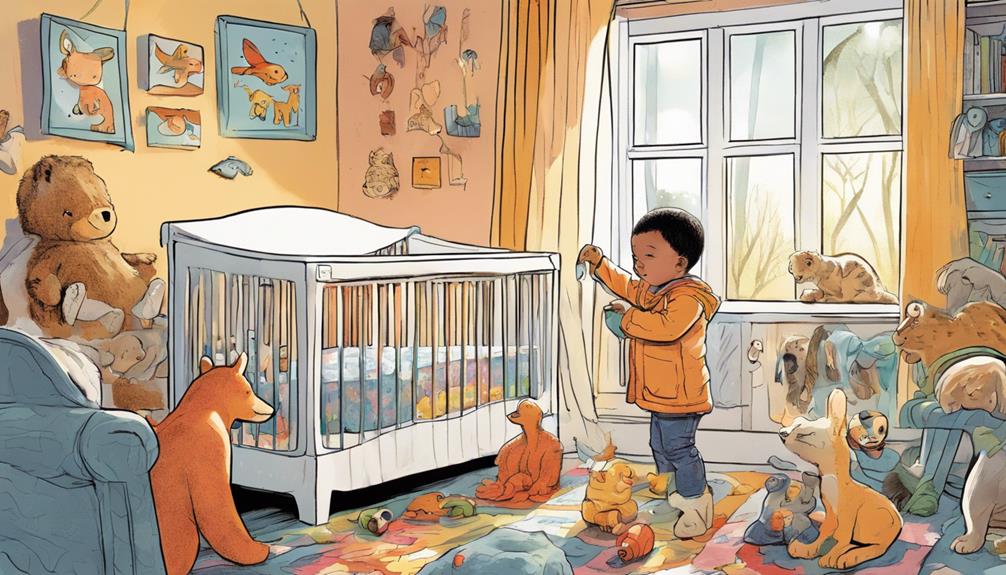
Understanding teething can help you separate fact from fiction, ensuring you're prepared for this natural stage in your baby's development. As your baby begins to show signs of teething, you might encounter several myths. Here are some essential facts to take into account:
- Teething Timeline: While teething can start as early as 3 months, most babies get their first teeth between 4 to 7 months.
- Symptoms Misunderstood: The American Dental Association clarifies that diarrhea and high fevers (over 100.4°F or 38°C) aren't typical signs of teething. If your baby experiences these, consult a pediatrician.
- Discomfort Levels Vary: Not every baby faces intense discomfort during teething. Some infants sail through the process with minimal signs or pain.
Common signs of teething include increased drooling and a desire to chew on objects. You might also notice irritability or disrupted sleep, but remember these can be linked to other developmental phases.
When to Consult a Pediatrician

If your baby hasn't started teething by 18 months, it's time to consult a pediatrician for a thorough evaluation of their dental development. Early intervention can help identify any underlying complications that may be affecting your child's growth.
Here are some additional signs that warrant a pediatrician consultation:
| Signs to Consult | Possible Concerns | Actions to Take |
|---|---|---|
| No teething by 18 months | Delayed dental development | Schedule a dental evaluation |
| High fever (100.4°F or higher) | Other health issues | Contact your pediatrician |
| Excessive irritability/sleep issues | Beyond typical teething symptoms | Seek professional advice |
| Swelling or unusual gum changes | Potential underlying complications | Get a thorough assessment |
If your baby is born with natal teeth or develops them shortly after birth, it's also advisable to consult a pediatrician. They can discuss any potential implications for your baby's dental health. Being proactive guarantees your little one's teething journey is as smooth and healthy as possible. Always trust your instincts; if something feels off, don't hesitate to consult.
Frequently Asked Questions
Can a 2 Month Old Be Teething?
Yes, a 2-month-old can show signs of teething, like increased drooling and a desire to chew. However, actual teeth usually don't erupt until 4 to 7 months, so consult a pediatrician for concerns.
What Is the Earliest a Baby Can Get Teeth?
You might be surprised to learn that some little ones can sprout their first teeth as early as a few months old, but most typically start this delightful journey around 6 months. Enjoy the adventure!
How to Know if Baby Is Teething?
To know if your baby's teething, watch for increased drooling, a strong desire to chew, and swollen gums. You might also notice irritability or disrupted sleep. If symptoms persist, consult your pediatrician for guidance.
What Is the Youngest Age to Get Teeth?
Notably, about 1 in 2,000 babies are born with teeth. Typically, though, the youngest age for teething is around 3 months, but every baby's timeline can vary greatly, so don't worry if it's later. It is important to monitor the development of a baby’s teeth, as they are crucial for their ability to eat, speak, and maintain proper alignment for their adult teeth. Baby teeth also play a role in facial development and overall oral health. This is why baby teeth matter and why it’s important to keep an eye on their growth and development.
At what age do babies typically start teething?
Babies typically start teething around the baby teething age range of 6 to 12 months. However, some babies can start as early as 3 months or as late as 14 months. It’s important to monitor your baby’s symptoms and provide comfort during this uncomfortable phase.
Conclusion
As your baby starts to teethe, remember that every child is different—some might begin as early as four months, while others may not get their first tooth until after their first birthday.
You may notice signs of discomfort, but don't panic; soothing methods can help.
However, if you ever feel unsure or overwhelmed, don't hesitate to reach out to your pediatrician.
The health of your baby's teeth is vital, and you'll want to make the best choices possible.
